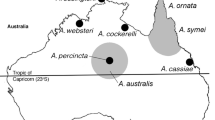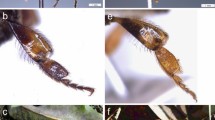Abstract
The bumblebees of the subgenus Bombus sensu strictu are a notoriously difficult taxonomic group because identification keys are based on the morphology of the sexuals, yet the workers are easily confused based on morphological characters alone. Based on a large field sample of workers putatively belonging to either B. terrestris or B. lucorum, we here test the applicability and accuracy of a frequently used taxonomic identification key for continental European bumblebees and mtDNA restriction fragment length polymorphism (RFLP) that are diagnostic for queens to distinguish between B. terrestris and B. lucorum, two highly abundant but easily confused species in Central Europe. Bumblebee workers were grouped into B. terrestris and B. lucorum either based on the taxonomic key or their mtDNA RFLP. We also genotyped all workers with six polymorphic microsatellite loci to show which grouping better matched a coherent Hardy-Weinberg population. Firstly we could show that the mtDNA RFLPs diagnostic in queens also allowed an unambiguous discrimination of the two species. Moreover, the population genetic data confirmed that the mtDNA RFLP method is superior to the taxonomic tools available. The morphological key provided 45% misclassifications for B. lucorum and 5% for B. terrestris. Hence, for studies on B. terrestris we recommend to double check species identity with mtDNA RFLP analysis, especially when conducted in Central Europe.
Zusammenfassung
Die Artbestimmung bei Hummelarbeiterinnen der Untergattung Bombus sensu strictu mittles morphologischer Merkmale hat sich wiederholt als schwierig erwiesen, da morphologische Bestimmungsmerkmale zwar bei Geschlechtstieren (Königinnen und Drohnen) eine gute Unterscheidung zulassen, bei Arbeiterinnen jedoch häufig uneindeutig sind.
Basierend auf einer grossen Freilandstichprobe von B. terrestris / B. lucorum Arbeiterinnen, zwei häufige, aber schwer zu unterscheidende mitteleuropäische Arten, testen wir hier die Anwendbarkeit und diagnostische Verlässlichkeit zweier Bestimmungsmethoden. Zum Einen, die eines häufig genutzten Bestimmungsschlüssels für mitteleuropäische Hummeln, zum Anderen, mtDNA Restriktions-Fragmentlängen-Polymorphismen (RFLP), die eine Artunterscheidung bei Königinnen von B. terrestris und B. lucorum erlauben. Die Hummelarbeiterinnen wurden dabei basierend auf entweder morphologischen Merkmalen oder anhand ihrer mtDNA RFLPs zu B. terrestris oder B. lucorum zugeordnet. Alle Individuen wurden an sechs Mikrosatelliten-Loci genotypisiert um zu testen, welche der beiden Artgruppierungen (Morphologie- oder mtDNA-basiert) besser mit einer zu erwartenden Hardy-Weinberg Population übereinstimmt.
Zum Ersten konnten wir zeigen, dass die für Königinnen diagnostischen mtDNA RFLPs auch bei Arbeiterinnen eine eindeutige Artbestimmung zulassen. Darüber hinaus konnten wir durch unsere populationsgenetischen Analysen bestätigen, dass die Artbestimmung mittels mtDNA RFLPs der durch morphologische Merkmale in Präzision deutlich überlegen ist. Die Artbestimmung mittels des Bestimmungsschlüssels führte zu 45% Fehlbestimmungen bei B. lucorum, Fehlbestimmungen bei B. terrestris wurden in 5% aller Fälle gefunden. Folglich empfehlen wir die verlässliche Artbestimmung mittels genetischer Methoden bei Studien an B. terrestris, vor allem, wenn diese in Mitteleuropa durchgeführt werden und populationsgenetische Untersuchungen beinhalten.
Similar content being viewed by others
References
Bertsch A. (1997) Abgrenzung der Hummel-Arten Bombus cryptarum und B. lucorum mittels männlicher Labialdrüsen-Sekrete und morphologischer Merkmale (Hymenoptera, Apidae), Entomol. Gen. 22, 129–145.
Bertsch A., Schweer H., Titze A., Tanaka H. (2005) Male labial gland secretions and mitochondrial DNA markers support species status of Bombus cryptarum and B. magnus (Hymenoptera: Apidae), Insect. Soc. 52, 45–54.
Chapman R.E., Wang J., Bourke A.F.G. (2003) Genetic analysis of spatial foraging patterns and resource sharing in bumblebee pollinators, Mol. Ecol. 12, 2801–2808.
Chittka L., Gumpert A., Kunze J. (1997) Foraging dynamics of bumble bees: correlates of movements within and between plant species, Behav. Ecol. 8, 239–249.
Darvill B., Knight M.E., Goulson D. (2005) Use of genetic markers to quantify bumblebee foraging range and nest density, Oikos 107, 471–478.
Dramstad W.E. (1996) Do bumblebees (Hymenoptera, Apidae) really forage close to their nests? J. Insect Behav. 9, 163–182.
Dramstad W.E., Fry G. (1995) Foraging activity of bumblebees (Bombus) in relation to flower resources on arable land, Agr. Ecosyst. Environ. 53, 123–135.
Dramstad W.E., Fry G.L.A., Schaffer M.J. (2003) Bumblebee foraging — in closer really better? Agr. Ecosyst. Environ. 95, 349–357.
Duchateau M.J., Velthuis H.H.W., Boomsma J.J. (2004) Sex ratio variation in the bumblebee Bombus terrestris, Behav. Ecol. 15, 71–82.
Ellis J.S., Knight M.E., Goulson D. (2005) Delineating species for conservation using mitochondrial sequence data: the taxonomic status of two problematic Bombus species (Hymenoptera: Apidae), J. Insect Conserv. 9, 75–83.
Ellis J.S., Knight M.E., Darvill B., Goulson D. (2006) Extremely low effective population sizes, genetic structuring and reduced genetic diversity in a threatened bumblebee species, Bombus sylvarum (Hymenoptera: Apidae), Mol. Ecol. 15, 4375–4386.
Estoup A., Solignac M., Harry M., Cornuet J.-M. (1993) Characterization of (GT)n and (CT)n microsatellites in two insect species Apis mellifera and Bombus terrestris, Nucleic Acids Research 21, 1427–1431.
Estoup A., Taillez C., Cornuet J.-M., Solignac M. (1995) Size homoplasy and mutationalprocesses of interrupted microsatellites in Apidae species, Apis mellifera and Bombus terrestris, Mol. Biol. Evol. 12, 1074–1084.
Falush D., Stephens M., Prichard J.K. (2003) Interference of population structure using multilocus genotype data: linked loci and correlated allele frequencies, Genetics 164, 1567–1587.
Fussell M., Corbet S.A. (1992) Flower usage by bumblebees: A basis for forage plant management, J. Appl. Ecol. 29, 451–465.
Gerloff C.U., Schmid-Hempel P. (2005) Inbreeding depression and family variation in a social insect, Bombus terrestris (Hymenoptera, Apidae), Oikos 111, 67–80.
Goudet J. (1995) FSTAT (Version 1.2): A computer program to calculate F-statistics, J. Hered. 86, 485–486.
Goulson D., Stout J.D. (2001) Homing ability of the bumblebee Bombus terrestris (Hymenoptera, Apidae), Apidologie 32, 105–111.
Hanley M.E., Franco M., Pichon S., Darvill B., Goulson D. (2008) Breeding system, pollinator choice and variation in pollen quality in British herbaceous plants, Funct. Ecol. 22, 592–598.
Hartl D.L., Clarke A.G. (1997) Principles of population genetics, 3rd ed., Sinauer Associates, Inc.
Herrmann F., Westphal C., Moritz R.F.A., Steffan-Dewenter I. (2007) Genetic diversity and mass resources promote colony size and forager densities of a social bee (Bombus pascuorum) in agricultural landscapes, Mol. Ecol. 16, 1167–1178.
Kalinowski S.T. (2005) HP-RARE 1.0: a computer program for performing rarefaction on measures of allelic richness, Mol. Ecol. Notes 5, 187–189.
Kraus F.B., Wolf S., Moritz R.F.A. (2009) Male flight distance and population sub-structure in the bumblebee Bombus terrestris, J. Anim. Ecol. 78, 247–252.
Kwon Y.J., Saeed S. (2003) Effect of temperature on the foraging activity of Bombus terrestris L. (Hymenoptera, Apidae) on greenhouse hot pepper (Capsicum annuum L.), Appl. Entomol. Zool. 38, 275–280.
Mauss V. (1994) Bestimmungsschlüssel für Hummeln, Deutscher Jugendbund für Naturbeobachtungen (DJN), Hamburg.
Meek B., Loxton D., Sparks T., Pywell R., Pickett H., Nowakowski M. (2002) The effect of arable field margin composition on invertebrate biodiversity, Biol. Conserv. 106, 259–271.
Michener C.D. (2000) Bees of the world, John Hopkins University Press, Maryland, USA.
Murray T.E., Fitzpatrick U., Brown M.J.F., Paxton R.J. (2008) Cryptic species diversity in a widespread bumble bee complex revealed using mitochondrial DNA RFLPs, Conserv. Gen. 9, 653–666.
Osborne J.L., Martin A.P., Carreck N.L., Swain J.L., Knight M.E., Goulson D., Hale R.J., Sanderson R.A. (2008) Bumblebee flight distances in relation to the forage landscape, J. Anim. Ecol. 77, 406–415.
Pritchard J.K., Stephens M., Donnelly P. (2000) Interference of population structure from multilocus genotype data, Genetics 155, 945–959.
Raine N.E., Chittka L. (2008) The correlation of learning speed and natural foraging success in bumblebees, Proc. R. Soc. London B 275, 803–808.
Raine N.E., Rossmo D.K., Le Comber S.C. (2009) Geographic profiling applied to testing models of bumblebee foraging, J. R. Soc. Interface 6, 307–319.
Saville N.M., Dramstad W.E., Fry G.L.A., Corbet S.A. (1997) Bumblebee movement in a fragmented agricultural landscape, Agr. Ecosyst. Environ. 61, 145–154.
Schmid-Hempel P., Durrer S. (1991) Parasites, floral resources and reproduction in natural populations of bumblebees, Oikos 62, 342–350.
Tanaka H., Roubik D.W., Kato M., Liew F., Gunsalam G. (2001) Phylogenetic position of Apis nuluensis of northern Borneo and phylogeography of A. cerana as inferred from mitochondrial DNA sequences, Insect. Soc. 48, 44–51.
von Hagen E. (1991) Hummeln: bestimmen, ansiedeln, vermehren, schützen, 3rd ed., Augsburg: Natur-Verlag.
Walsh P.S., Metzger D.A., Higuchi R. (1991) Chelex 100 as a medium for simple extraction of DNA for PCR-based typing from forensic material, Biotechniques 10, 506–512.
Wang J. (2004) Sibship reconstruction from genetic data with typing errors, Genetics 166, 1963–1979.
Waser N.M., Chittka L., Price M.V., Williams N.M., Ollerton J. (1996) Generalization in pollination systems, and why it matters, Ecology 77, 1043–1060.
Westphal C., Steffan-Dewenter I., Tscharntke T. (2006) Bumblebees experience landscapes at different spatial scales: possible implications for coexistence, Oecologia 149, 289–300.
Widmer A., Schmid-Hempel P., Estoup A., Scholl A. (1998) Population genetic structure and colonization history of Bombus terrestris s.l. (Hymenoptera: Apidae) from the Canary Islands and Madeira, Heredity 81, 568–572.
Williams P.H. (1994) Phylogenetic relationships among bumble bees (Bombus Latr.): a reappraisal of morphological evidence, Syst. Entomol. 19, 327–344.
Williams P.H. (1998) An annotated checklist of bumble bees with an analysis of patterns of description (Hymenoptera: Apidae, Bombini), Bull. Nat. Hist. Museum (Entomology) 67, 79–152.
Wolf S., Moritz R.F.A. (2008) Foraging distance in Bombus terrestris (Hymenoptera: Apidae), Apidologie 39, 419–427.
Wolf S., Moritz R.F.A. (2009) Pollination potential of bumblebee (Bombus spec.) drones (Hymenoptera: Apidae), submitted.
Author information
Authors and Affiliations
Corresponding author
Additional information
Manuscript editor: Stefan Fuchs
Rights and permissions
About this article
Cite this article
Wolf, S., Rohde, M. & Moritz, R.F.A. The reliability of morphological traits in the differentiation of Bombus terrestris and B. lucorum (Hymenoptera: Apidae). Apidologie 41, 45–53 (2010). https://doi.org/10.1051/apido/2009048
Received:
Revised:
Accepted:
Issue Date:
DOI: https://doi.org/10.1051/apido/2009048




